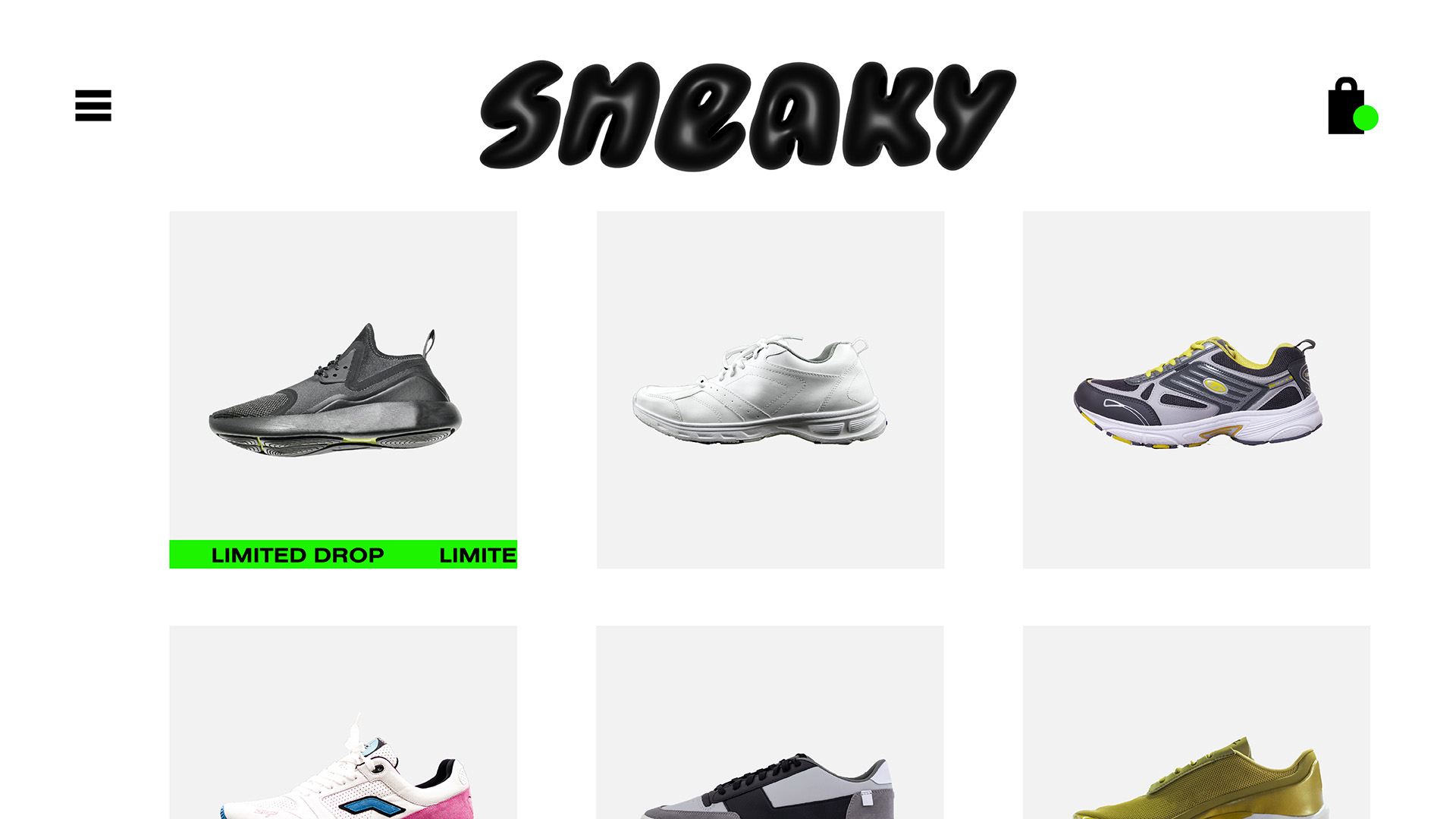Online queue systems: How they work, benefits & examples
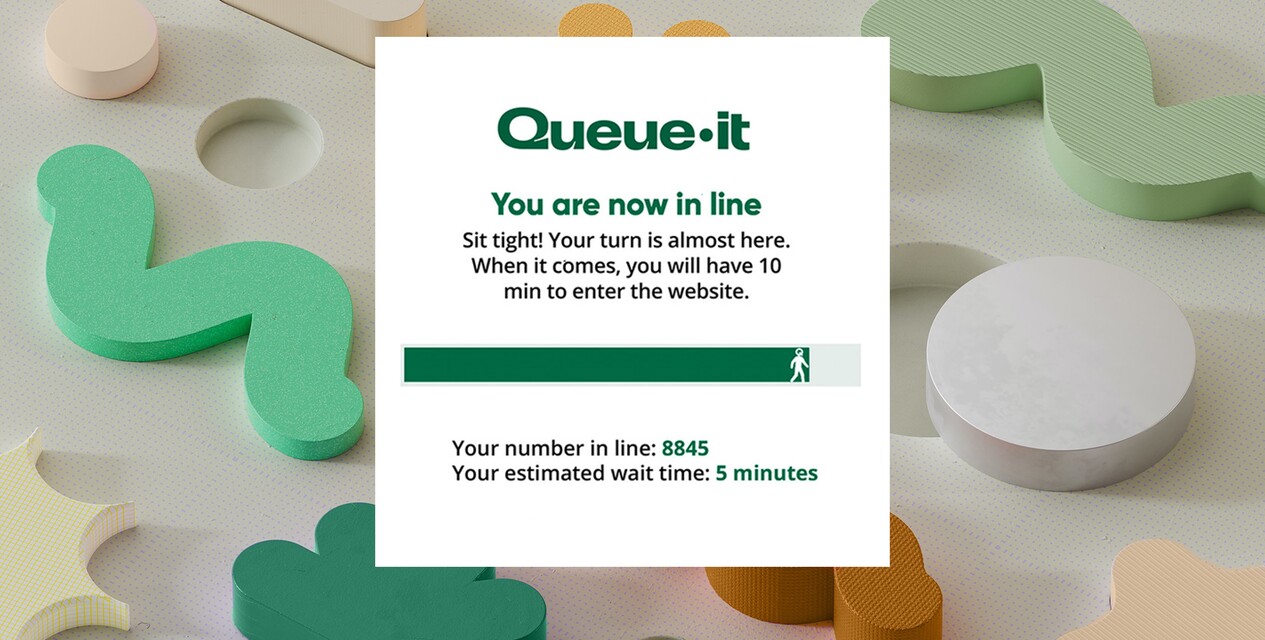
What are online queue systems? How do online queues work? And why do businesses and organizations queue people online? Get the answers to these questions and more in this comprehensive guide to online queuing.
Table of contents
- What is an online queue system?
- How do online queues work?
- Are online queues random or first-in, first-out?
- Which companies & organizations use online queues?
- Why do companies use online queue systems?
- What are the benefits of online queue software?
An online queue system is a software-as-a-service (SaaS) solution used by businesses and organizations to control web traffic and improve the user experience. Like physical queues, online queues manage traffic flow to keep websites and apps online and ensure fairness in high-demand scenarios like concert ticket sales, sneaker drops, and government registrations.
Have you ever been on a website that slows down, bugs out, or crashes during a popular event? Or seen a headline like “Thousands left frustrated & empty-handed after company’s website crashed”?

Online queuing systems prevent the frustration, negative feedback, and lost sales caused by website crashes. They’re used by companies like Ticketmaster, SNIPES, and The North Face to keep their sites online and give you a smooth, fair, and informed experience like the one shown in the online queue example page below.
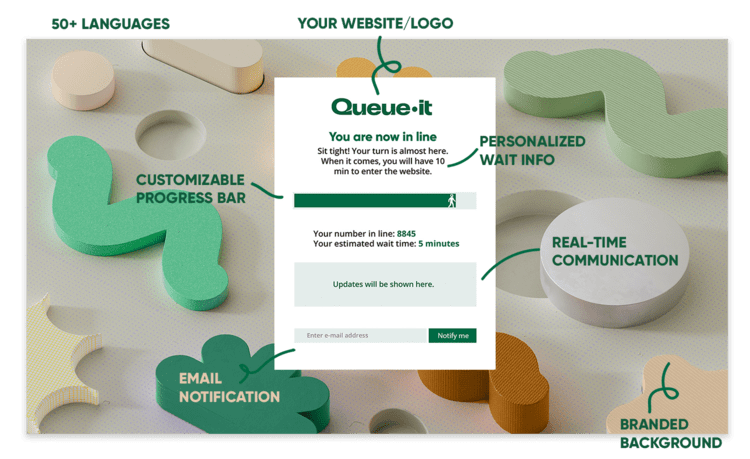
Some online queues are just basic holding pages that refresh every few seconds and let customers in at random. But sophisticated digital queue systems like Queue-it provide a range of features to ensure fairness, keep you informed, and give you flexibility to queue your way. These include:
- Fair first-in, first-out queuing
- Your position in line
- Your progress through the queue
- Your estimated wait time
- The ability to get an email notification when it’s your turn
- The ability to transfer your queue position between devices without losing your spot
If you’re placed in an online queue, you’ll typically experience a short wait. Then, when it’s your turn, you’ll automatically be flowed from the web queue to the webpage or app you were trying to access.
RELATED: Virtual Waiting Room Buyer's Guide: How to Choose Your Virtual Queue System
Online queues work by automatically redirecting site visitors to a waiting room page when they perform an action the website owner needs to protect—such as visiting a particular page or trying to check out—or when traffic surges to a level that could crash the website or harm performance.
Web-based queue systems use a simple HTTP 302 redirect to seamlessly flow visitors from the target site to a completely customizable online queue page, where they get detailed wait info.
When it’s their turn, visitors are flowed back to the website with a token that lets them use the site with no restrictions.
Online queues often look like the website visitors were trying to access in both style and URL. But the visitors waiting in queue online are hosted on the online queue provider’s infrastructure, meaning they place no strain on the target website’s servers.
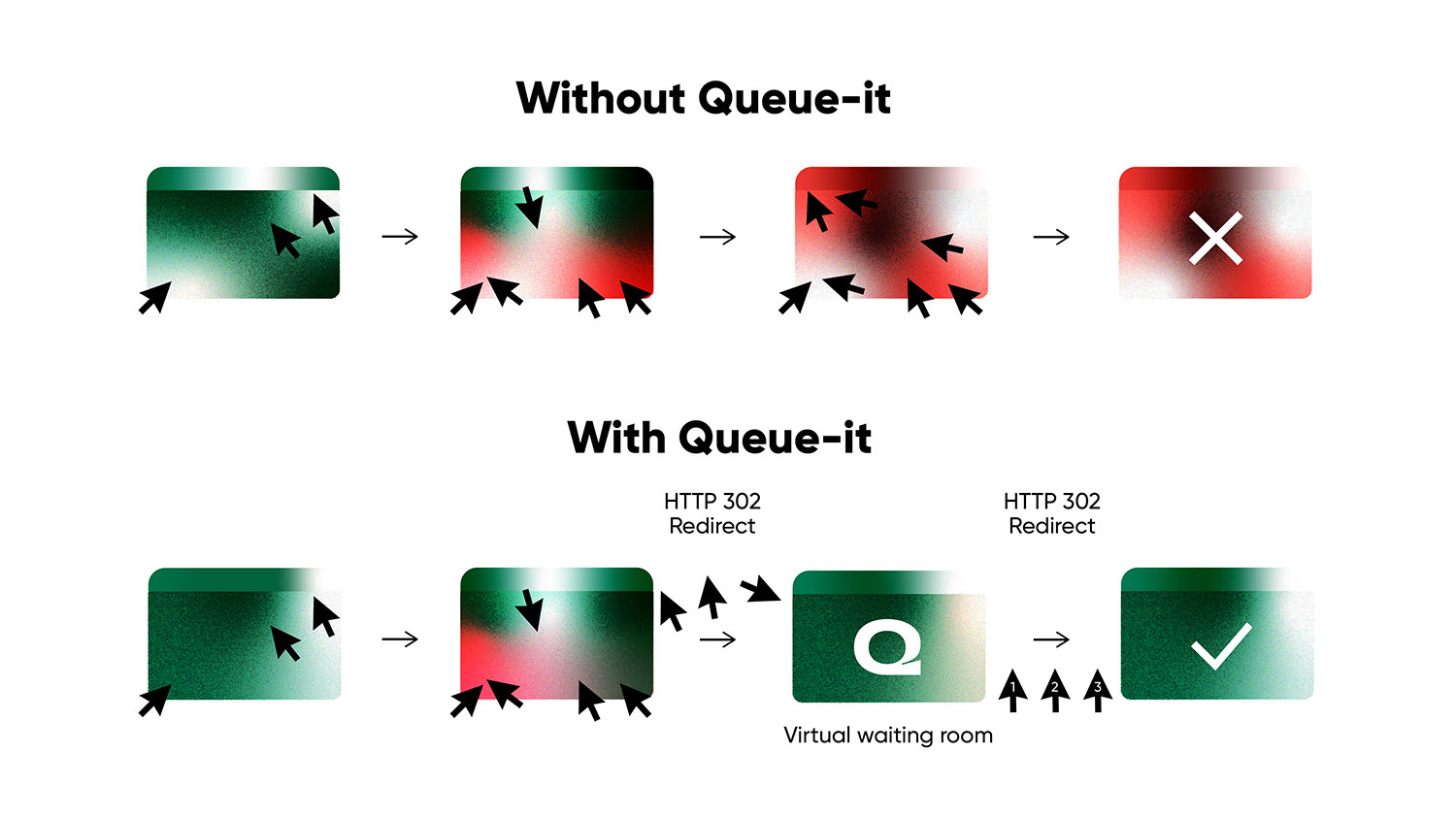
The company using the online queue system can flow the traffic to their site at exactly the rate they choose—whether that’s 100, 1,000, or 10,000 visitors per minute. They can also adjust this traffic flow up or down in real time based on how systems are performing.
Online ticket sales are one of the most common places you'll see queue systems online. So how do online ticket queues work?
- The ticketing company knows their site can stay online with up to 1,000 purchases per minute, but they’re expecting more visitors than that for an upcoming concert ticket sale
- They set up an online queue and configure it to send visitors to their site at a rate of 500 visitors per minute
- When the tickets go live, 10,000 visitors rush to the site in the first two minutes
- Instead of these visitors crashing the site, they’re redirected to the online ticket queuing system, where they get flowed to the site at the 500 per minute rate set by the ticketing company
- Visitors get access in fair order, and those waiting can see their spot in line, their progress, and how long they’ll have to wait
- Within 20 minutes, all 10,000 of these visitors have gotten access to the site
- The company stays online, sells all their tickets with no issues, and gives every customer a smooth and fair experience
“The feedback on Queue-it has been kind of overwhelmingly positive. It's anecdotal, but I’ve seen tweets and emails from people that said ‘Thanks, it was a really great experience.’ Or, you know, ‘I got the ticket I wanted and I loved the give us your email feature.’”
JON HAWORTH, SR. COMMERCIAL SYSTEMS MANAGER

Online queues operate differently depending on which software solution a company chooses and how they choose to use it. Queue-it, for instance, offers three different queuing strategies you can choose from depending on the event and the organizer’s preferences:
- The insurance strategy (for 24/7 peak protection)
- The timed release strategy (for scheduled sales or registrations)
- The exclusive access strategy (for exclusive or early access events)
Whether the website queue is random or first-in, first-out depends on which of these three online queue management strategies is used. So let’s dig a bit deeper into how each strategy works and when a company or organization would use it.
When companies use online queues for 24/7 protection, the queue operates as a standard first-in, first-out (FIFO) queue. This means the first visitor who entered the queue is the first visitor to get access to the website, and the last visitor to enter the queue is the last one to get site access.
You can’t predict every traffic spike. That’s why many companies and organizations use the insurance strategy. It enables the online queue system to monitor their traffic 24/7 and only activate when traffic reaches a set threshold.
With the insurance strategy, you can set and forget your online queue. You just determine the level of traffic where you’re likely to experience issues, then configure the online queue to activate when traffic gets close to those levels. Most visitors will never see the queue system online, but you’re protected against traffic peaks regardless.
The insurance strategy is useful for companies that experience unpredictable traffic spikes caused by:
- PR appearances or features in major new outlets
- A celebrity or influencer mentioning your brand or using your products publicly
- A viral social media post or making it to the frontpage of Reddit (called the “Reddit hug of death” or the “Slashdot effect”)
Home Office, which provides the U.K.’s passports, for example, often experiences large spikes in traffic when they're mentioned in the press or linked to in a large outlet. That's why they use the insurance strategy for their online queueing system.
The chart below shows how, across just two days, Home Office’s traffic fluctuates wildly, with several traffic peaks that exceed their maximum capacity. Home Office controls and manages these peaks with Queue-it’s website queuing system, which helps ensure the critical service never goes offline.
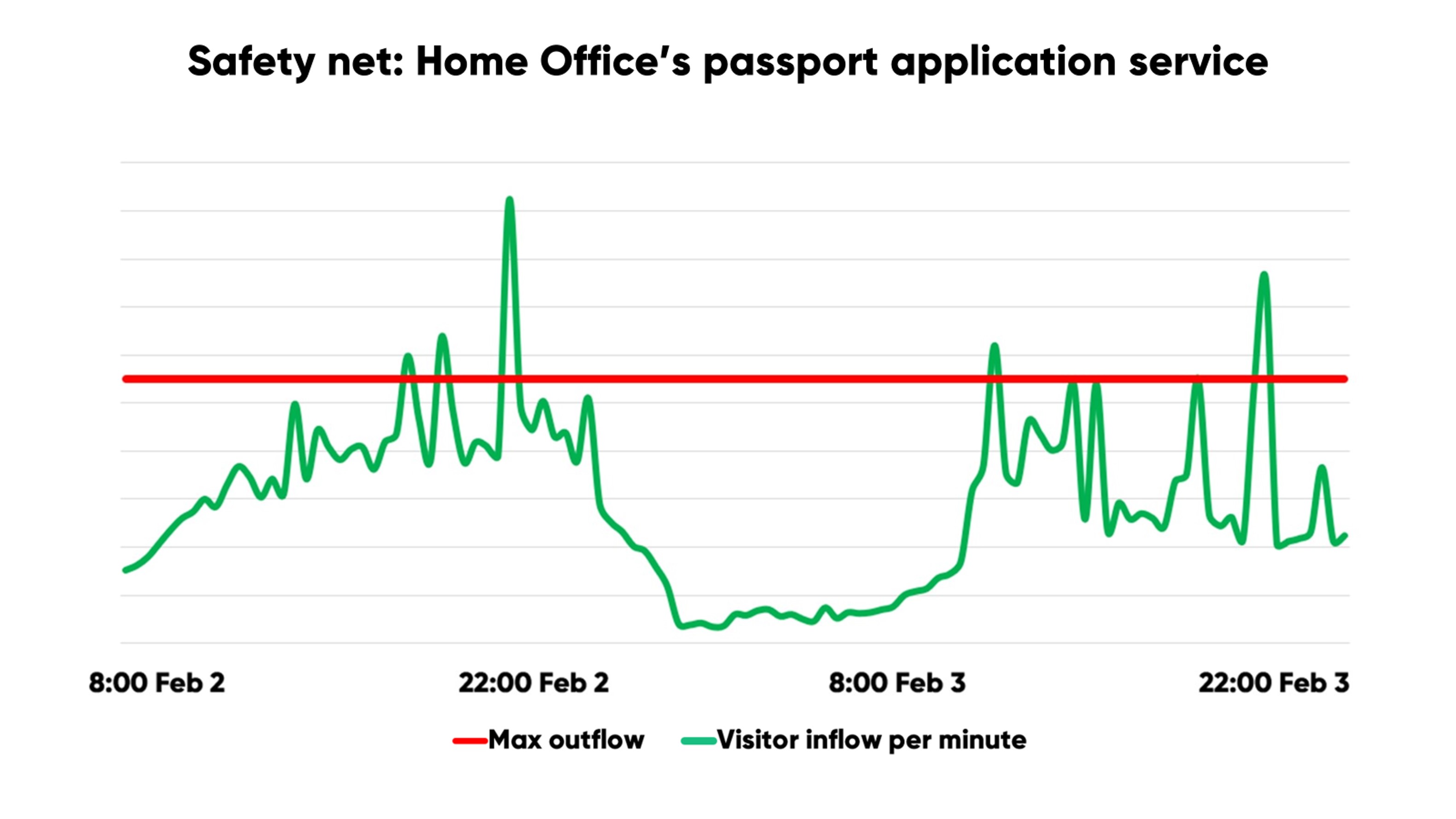
“Passports is one of the biggest digital services in the U.K. and we don’t collapse under pressure. Since we’ve had Queue-it we haven’t even come close. To be able to say we’ve had zero outages in the face of what was at least triple the amount of demand that we would expect is amazing. It's a really, really positive thing.”
KEVIN LEWIS, PRODUCT MANAGER

When companies run scheduled sales or registrations, such as product launches or ticket sales, Queue-it’s online queue system can be used to deliver both randomization and first-in, first-out (FIFO) queuing.
With the timed release strategy, all visitors who show up before a sale or registration go live are redirected to a pre-queue page with a countdown timer. When the timer reaches zero, visitors in the pre-queue are randomized, like a raffle. They’re then placed into a standard online queue in their randomized order. Visitors who join after this process get added to the back of the queue and proceed to the site in FIFO order.
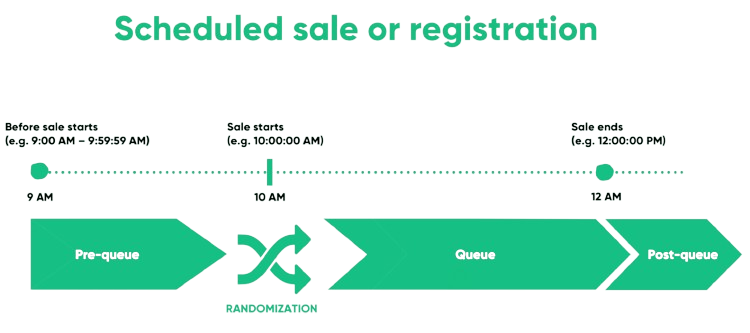
The carousel below illustrates the three stages of the user journey during a virtual queue for a timed release, such as a sneaker drop:
- A waiting room page with a countdown timer
- An online queue with detailed wait information
- Your website, which they’ll be flowed to when it’s their turn
Combining randomization and FIFO queuing offers three key benefits:
- It ensures all visitors who show up on time get an equal chance
- It protects the site from early spikes in traffic
- It removes the unfair speed advantages of online shopping bots
The chart below shows how the timed release strategy protects websites during large scheduled events. The traffic data comes from food chain MOS BURGER’s collaborative product drop with a famous Japanese cartoon character. It shows how scheduled sales can see traffic surge from zero to 2,000 visitors per minute in a single minute.
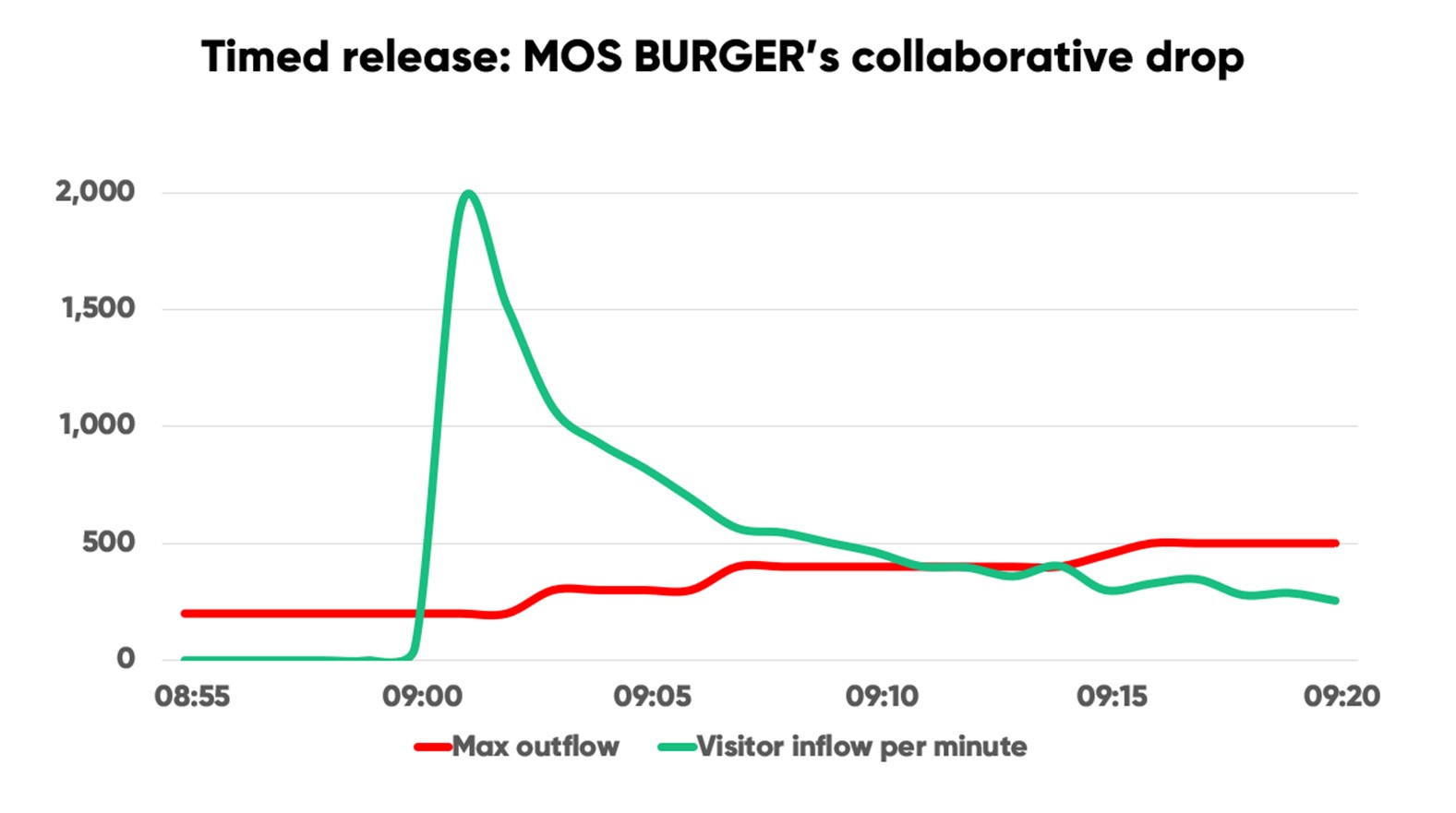
With Queue-it in place, all this traffic gets sent directly to the online queue, then flowed back to the target page at a controlled rate of 300-500 per minute.
“The day went very smoothly … We captured every sale without a crash or a delay. We say many positive posts on social media about the waiting room.”
RYOBUN MORINAGA, DIGITAL PROMOTION DEPARTMENT, MOS FOOD SERVICES
If you’re using an online queue to give customers early or exclusive access, it typically operates in the same way as if you’re using it for a timed release. The key difference is that the only visitors who can enter the queue—and in turn access the target website or page—are the ones you’ve invited.
The exclusive access strategy is run using an invite-only waiting room. It lets you incentivize loyalty program sign-ups and reward your most valuable customers while keeping out bots and resellers.
To give exclusive access with an invite-only waiting room, you simply:
- Upload the list of customer emails to which you’d like to give access
- Send out the list of automatically generated single-use links OR add an email verification field to your virtual queue
- Then activate your event, confident that no one but the people you’ve chosen can get access
You can see user journey of an exclusive access online queue in the carousel below.
Danish ecommerce brand Bedre Nætter used the exclusive access strategy to protect their site and give their loyalty members early access to Black Friday deals.
They set up two waiting rooms. One that could be accessed by anyone, and one exclusively accessible by members.
The chart below shows how they flowed visitors from the members-only queue until all members got an opportunity to checkout. Once the exclusive queue was empty, they opened the general queue in pre-queue mode, collected customers, and throttled them to the site.
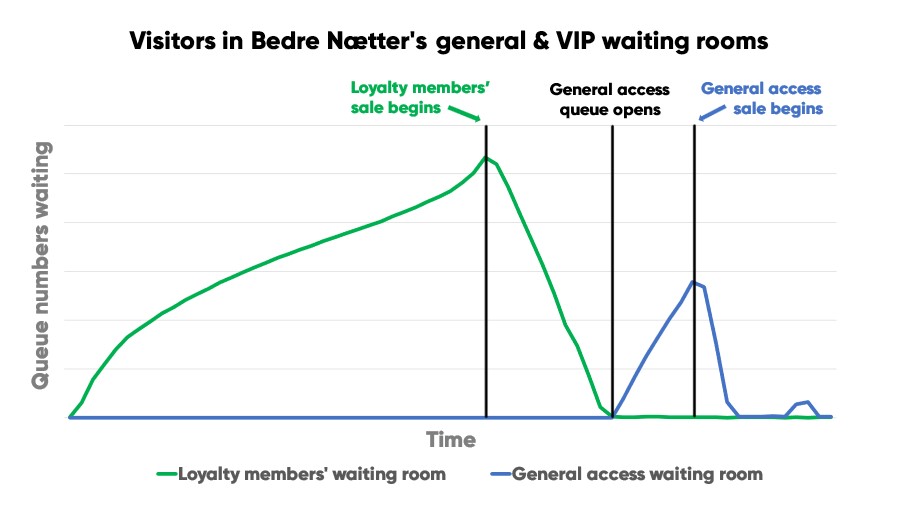
The queue for the general public also had an email field which explained that if customers joined their VIP program, they’d get access to Black Friday deals four hours before the general public. One in every four visitors who viewed this page joined Bedre Nætter’s loyalty program.
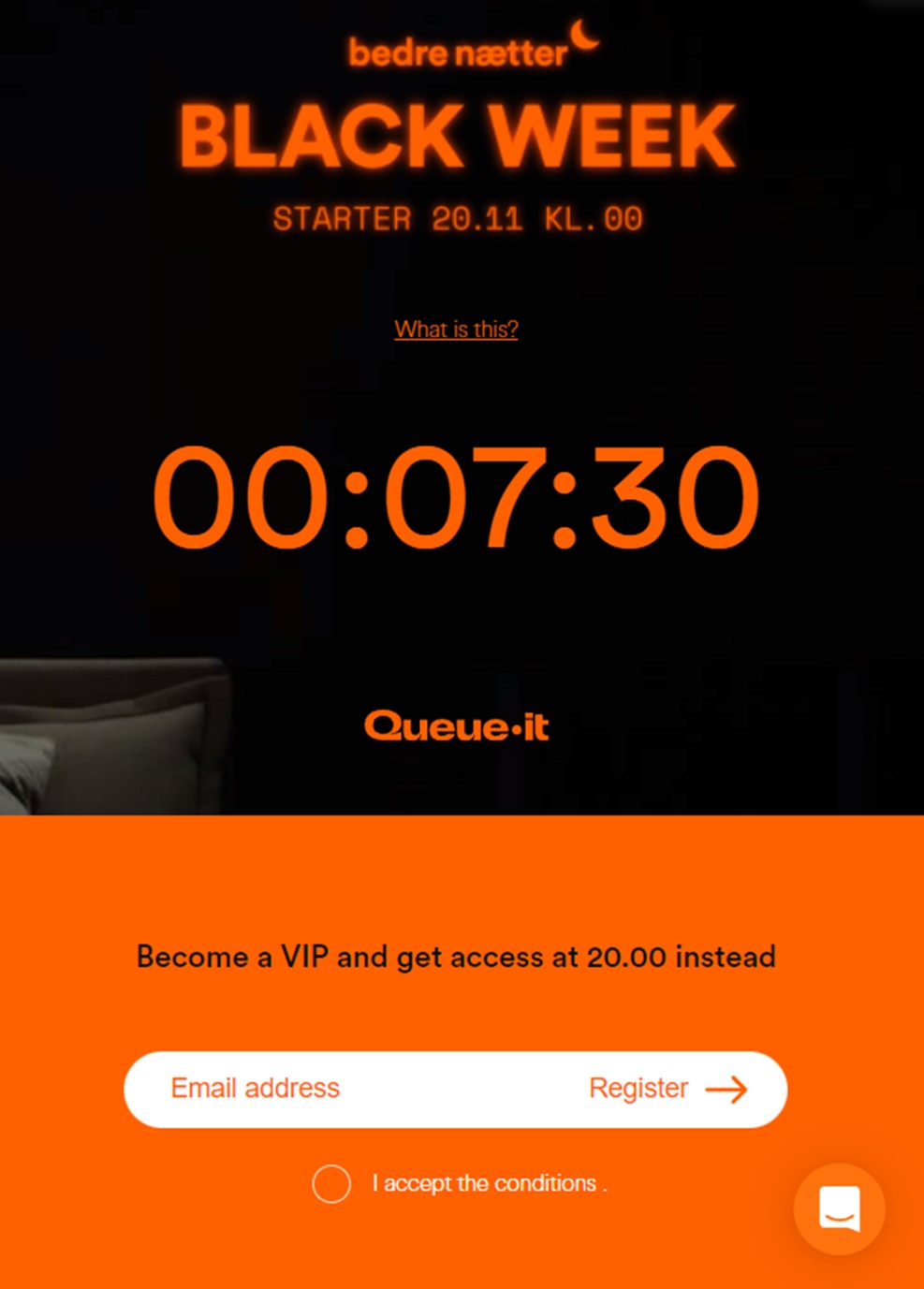
“All the members that came through the invite-only queue had a very high conversion rate. We hit our sales target for the night in the first 11 minutes. In just three hours, we hit the sales target for the whole week.”
MARCUS FORSBERG, HEAD OF ECOMMERCE & PERFORMANCe

Just like physical queues, companies use online queues when demand is high and there’s a need to fairly allocate goods or services.
This scenario occurs across a wide range of companies and organizations across industries and use cases, including:
- SNIPES during hyped sneaker drops
- Peach Aviation during airline ticket flash sales
- London School of Economics during class registrations
- StubHub during major K-pop ticket sales
- Currys during Holiday Season sales
- The North Face during exclusive product drops
- Bend Parks and Recreation during recreation activity registrations
- Telenor during iPhone launches
All these organizations use Queue-it’s online queue system to keep their websites up and running smoothly on their busiest days—protecting their revenue, reputation, and customer trust and loyalty.
Major businesses and organizations use online queue systems to create a fair, reliable, and seamless online experience, no matter the demand.
But why do they need a website queue system to achieve that? Why don’t they just scale up or out?
They do scale. But at scale, everything breaks.
There is no “too big to fail” on the world wide web. Amazon, Walmart, Apple, the IRS—surging web traffic has taken all of them offline.
To prepare for a large spike in traffic, you need to optimize your systems in many ways, including scaling your infrastructure.
But scaling alone is expensive at best, and risky at worst:
- Expensive: If don’t know how many visitors you’ll get, you must scale to handle the upper limits of your predictions to keep your site online. When these visitors show up in random patterns, you must keep your site scaled for peak load for the duration of an event. The costs of this add up fast.
- Complex: While scaling your servers on the cloud may be relatively easy, getting each component of your tech stack to scale—either automatically or manually—is a difficult, expensive, and sometimes impossible task. You may have to go through the lengthy and pricey process of re-architecting systems and upgrading subscription levels with third-party vendors.
- Risky: Estimating traffic levels is difficult, making pre-scaling a risky strategy. Autoscaling also introduces risk, because of its delayed reaction time. Even if these approaches could handle sudden surges in traffic, bottlenecks almost always emerge at scale. This means traffic still overloads areas that are difficult or impossible to scale, such as databases, inventory management systems, third-party services like payment gateways, and performance-intensive features like dynamic search or a “recommended for you” panel.
RELATED: 3 Autoscaling Challenges & How To Overcome Them With an Online Queue
Online queuing systems do what scaling cannot: they control the flow of online visitors.
A web-based queue system complements scaling, allowing you to proactively protect your site against sudden spikes, safeguard key bottlenecks, and ensure scaling costs don’t get out of control. And as a bolt-on tool, the online queue system doesn’t require you to re-architect systems for high-traffic events that only occur a few times a year.
“Autoscaling doesn’t always react fast enough to ensure we stay online. Plus, it’s very expensive to autoscale every time there’s high traffic. If we did this for every traffic spike, it would cost more than double what we pay for Queue-it. So Queue-it was just the better approach, both in terms of reliability and cost.”
MIJAIL PAZ, HEAD OF TECHNOLOGY

The value of online queuing software lies in the control it gives you. A good solution offers not only control over traffic flow, but also over the customer experience, productivity and efficiency, and scaling costs.
Online queues ensure high demand never gets in the way of delivering a top-tier customer experience. One in three customers will leave a brand they love after just one bad experience. And uncontrolled traffic creates poor experiences in several ways:
- Site or app crashes
- Site or app slowdowns
- Overselling
- Issues in the user journey such as payment or inventory errors
- Instant unfair sell-outs caused by bots and resellers
Queue online systems let you avoid these issues to ensure every site visitor gets a smooth, fast, and seamless online experience. But they’re not just a defensive measure, they’re also designed to actively improve user experience and create marketing opportunities by facilitating communication, excitement, and fairness for customers.
RELATED: Your Digital Billboard: 12 Ways To Use Your Online Queue As a Marketing Asset
That’s why in a recent survey of customers using Queue-it’s online queue:
- 88% said their customers’ online experience improved
- 71% saw fewer customer complaints for sales/registrations
- 81% said their sales are fairer with Queue-it
“Queue-it made everything more pleasant for the customer experience and the social media complaints disappeared. Having only one person to set-up the technology together with the Queue-it team saved us a lot of time, human resources, and money.”
ROBERT WILLIAMS, DIGITAL MANAGER

Big events are a big strain on human resources. High traffic doesn’t just stress your infrastructure, it stresses your staff. Several managers we’ve spoken to say they’ve lost talented engineers who were fed-up with constantly putting out fires and solving issues caused by traffic spikes and bots.
There’s a few key ways Queue-it makes running large-scale events more efficient and stress-free:
- Reduces prep work for large-scale online events by limiting the need to test, scale, and optimize or re-architect systems
- Increases operational efficiency by avoiding issues like overselling and errors in the customer journey, which strain support teams
- Improves employee efficiency by enabling commercial teams to run large-scale events without complete reliance on technical teams
- Provides expertise and support by giving you access to Queue-it’s team of peak traffic experts—who’ve been on hand with some of the world’s biggest companies on their busiest days
Online queues let your commercial teams execute their big ideas without tech teams stressing about the website staying online. Customer survey results show Queue-it’s positive impact on stress, productivity, and efficiency:
- 76% say running sales and registrations is less stressful with Queue-it
- 58% average reduction in staff needed on-call during sales/registrations
- 85% sell through product more efficiently with Queue-it
“Before Queue-it, traffic peaks caused a lot of stress for us. We worried the server would crash, and even if it didn’t, we knew it would impact our ability to deliver a good user experience. But with the virtual waiting room in place, we feel protected, and we can focus on monitoring our sales activity. There’s a huge change in our state of mind.”
ATSUMI MURAKAMI, CHIEF OF INNOVATION

As we’ve covered, scaling costs can quickly get out of control before and/or during large-scale events. Scaling for temporary peaks in traffic is typically exorbitantly expensive for many reasons:
- The costs of overprovisioning during the event
- The costs of testing and optimizing systems
- The costs of upgrading vendor subscription tiers
- The cost of re-architecting systems if necessary
- The costs of downtime if you fail to handle demand
Online queues allow you to keep these costs under control by letting your existing site perform like one that’s purpose built for high traffic, meaning you don’t have to re-architect or upgrade subscription tiers.
They also let you avoid overprovisioning by enabling you to scale to a fixed point then operate at max capacity without the risk of failure.
And, of course, they prevent the costs of downtime by ensuring your site stays online under the most extreme traffic spikes.
That’s why Queue-it customers reported an average reduction of 37% in server scaling costs, as well as an average reduction of 33% in database scaling costs.
“We were not completely convinced with scaling up or changing ecommerce infrastructure because it requires a lot of resources. With Queue-it, we can efficiently protect against traffic peaks. Overall, it’s helped us save about 1 million JPY per year.”
JUNJI HAYASHI, CEO

By now you should know everything you need to know about online queues and why businesses and organizations across the globe use them.
If you’re interested in trying out an online queue system for your site or app, book a tailored product demo to see Queue-it in action and speak to our peak traffic experts.
Queue-it is the market leading online queue system provider, having served over 75 billion users across 172 countries. With a mission to deliver online fairness to all, Queue-it empowers the world’s biggest businesses to perform on their busiest days. When Ticketmaster, The North Face, and The State of New Hampshire need to manage high demand events, they turn to Queue-it.


